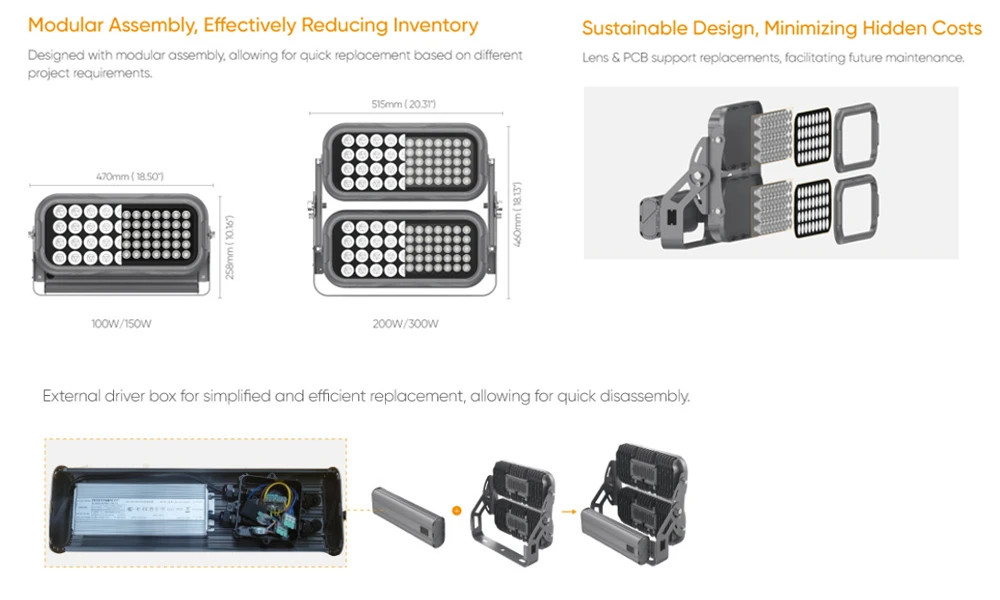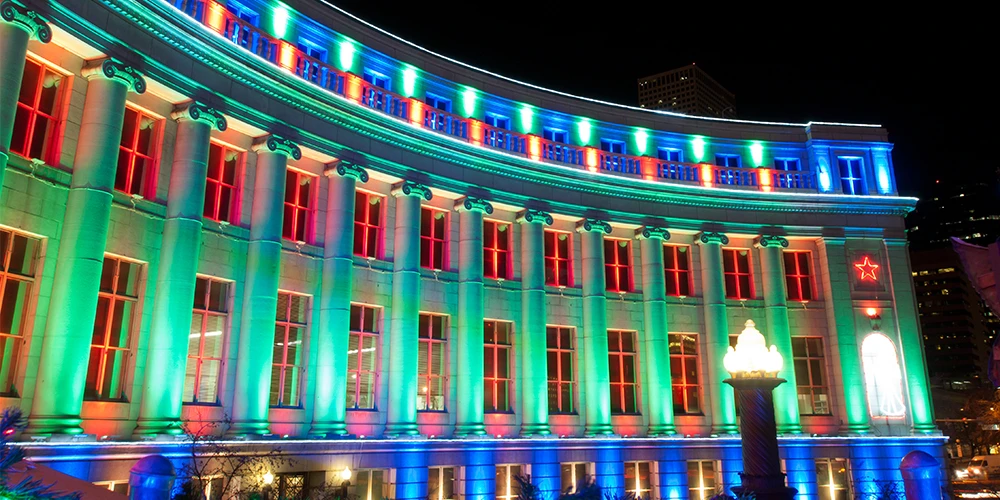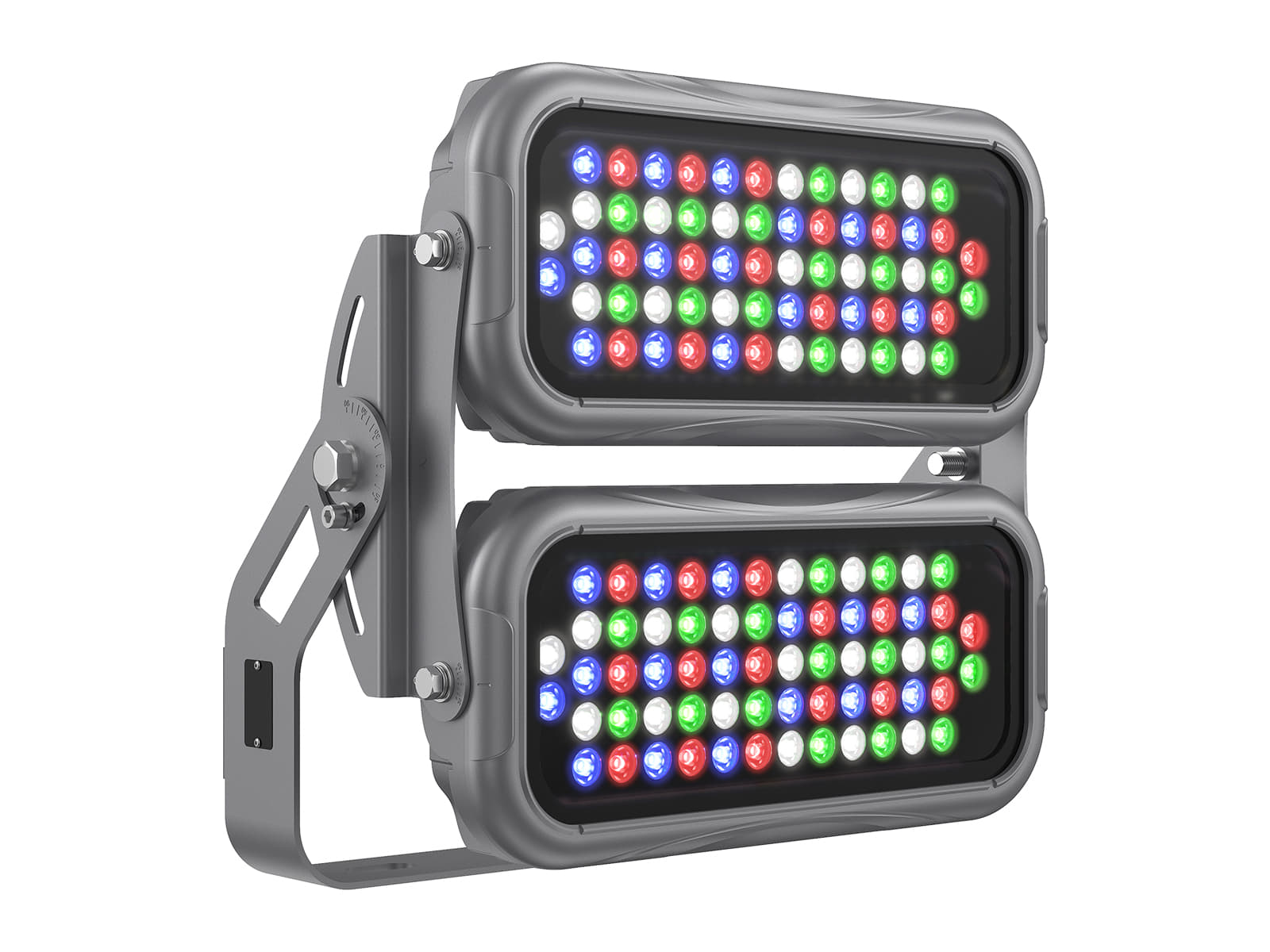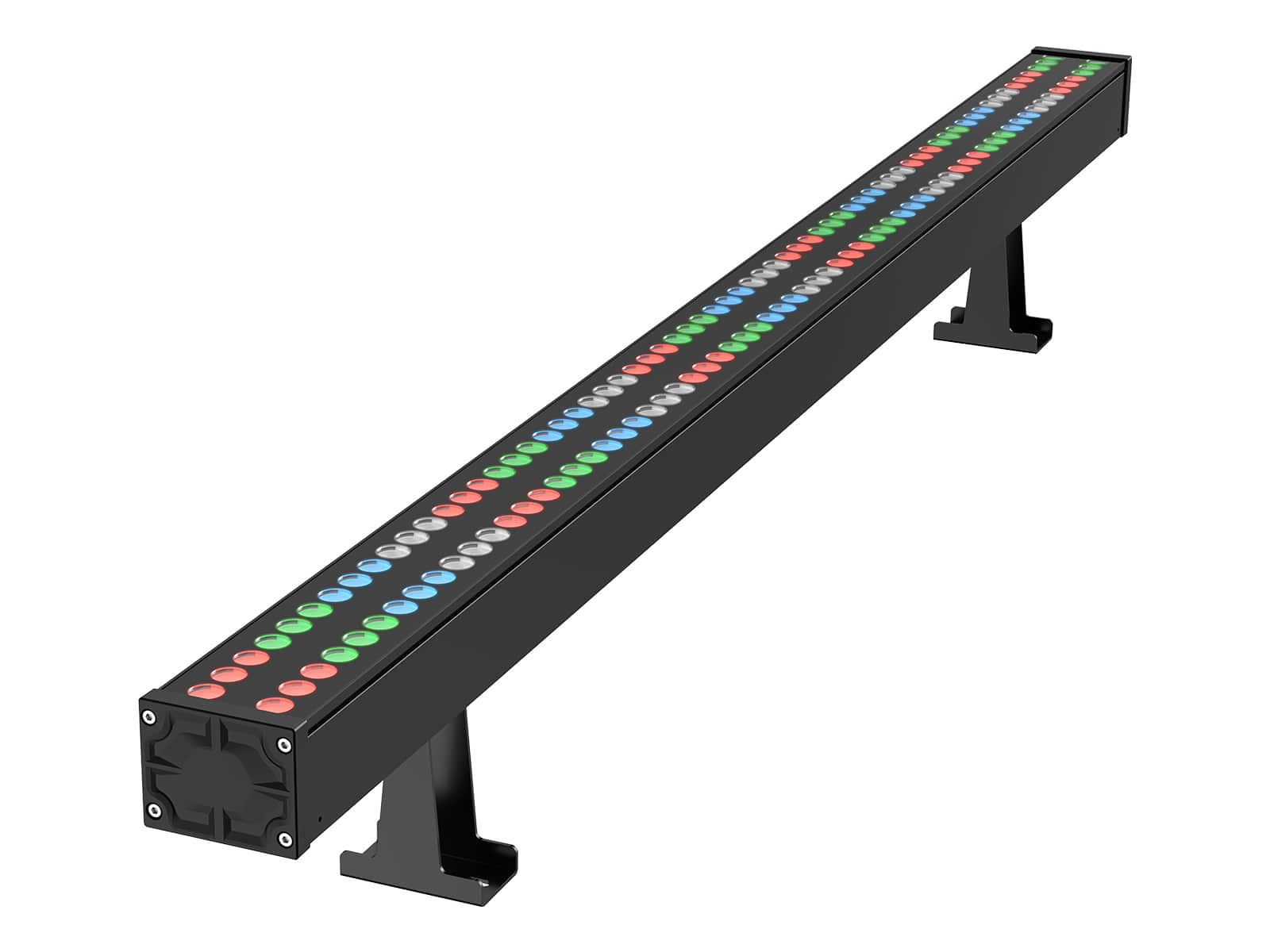The landmarks, buildings, bridges, and other architectures that define a city are at the heart of its unique heritage and identity. As people increasingly enjoy late-night outdoor activities, the demand for vibrant lighting solutions continues to grow. RGB(W) lighting offers a significant opportunity to enhance tourism strategies by transforming architectures into dynamic, visually captivating environments. This kind of lighting not only elevates the city’s aesthetic appeal but also drives revenue and boosts prestige.
At AGC, we offer a wide range of RGB/RGBW architectural lighting solutions known for their exceptional reliability and performance. In this blog, we’ll explore the world of RGB(W) architectural lighting and equip you with the knowledge you need to choose the best one for your exterior architectural lighting project.
What is RGB(W) lighting
RGB stands for red, green, and blue. However, these aren’t the only colors an RGB light can produce. By adjusting the intensity of each of these three primary colors within its diodes, an RGB light can blend a wide range of colors. This allows RGB lights to produce output across the entire color gamut.
The "W" in RGBW refers to white. RGBW lighting combines red, green, blue, and white LEDs to create a broader array of colors and lighting effects. Compared to RGB lighting, RGBW offers superior white light quality, increased brightness, and enhanced color accuracy.
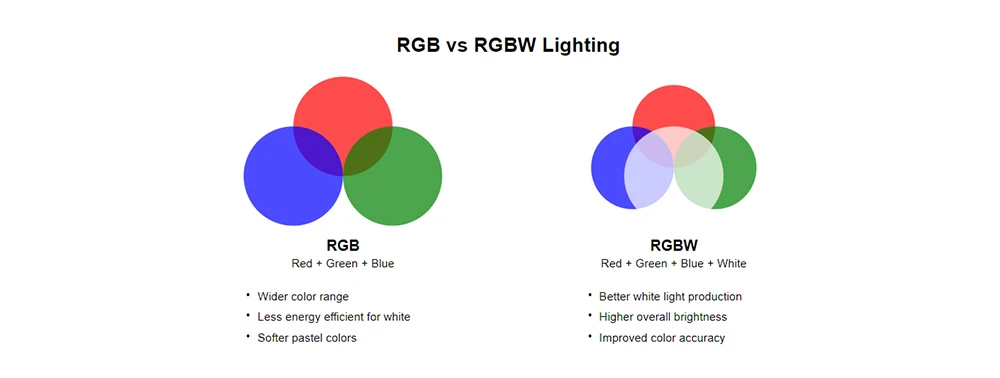
Types of RGB(W) architecture lights
AGC offers LED RGB(W) lights for all types of buildings, whether new, historic, or monumental. There are two main types of RGB(W) architecture lights: floodlights and wall washers. They provide colorful illumination to the facades, arches, windows, structures, or columns of the architecture
Floodlights
Floodlights play a crucial role in enhancing architectural exteriors, commonly used to illuminate walls, facades, and monuments.
At AGC, our RGB(W) floodlights are available with a range of optics, from narrow to wide beams, offering nearly limitless possibilities for creating stunning lighting effects. With a narrow beam, floodlights can deliver focused light, highlighting specific architectural features and creating a bold contrast against the background. On the other hand, wider beams provide softer lighting that covers larger areas more evenly.
Wall washers
Wall washer lights are designed to illuminate the vertical surface evenly, creating a smooth, “washed” effect. This is achieved by positioning the lighting fixture close to the surface, ensuring the light spreads evenly across the surface. Wall washers are commonly used to reveal the texture and morphology of the architecture or to obtain a soft and homogeneous wash of light.
To optimize visual comfort and ensure uniform light distribution, our wall washers are available with anti-glare accessories, including visors, honeycomb, and grids. These components effectively minimize glare and enhance the overall quality of illumination.
Key factors to consider when choosing RGB(W) architecture lights
RGB(W) lights offer a versatile and dynamic solution to create captivating visual experiences. Dynamic color changes in lighting attract a large number of people. But this is based on the right RGB (W) lighting solutions. There are some key considerations to choose the most suitable lighting solution that meets both aesthetic and functional requirements.
Color quality and rage
Both RGB and RGBW lighting can bring dynamic lighting effects to architectures. RGBW lights are an improvement over standard RGB lighting because they offer a wide range of colors and more accurate color rendering. However, it does not mean RGBW lights are always better than RGB lights. It depends.
In architectural lighting, flexibility is essential, as lighting needs can change based on different occasions like festivals, holidays, or events. To address these varying requirements, our RGBW lights offer three distinct lighting modes: single white, RGB, and RGBW. These options allow you to easily adjust the lighting to suit any occasion, creating dynamic visual effects and enriching the atmosphere of any space.
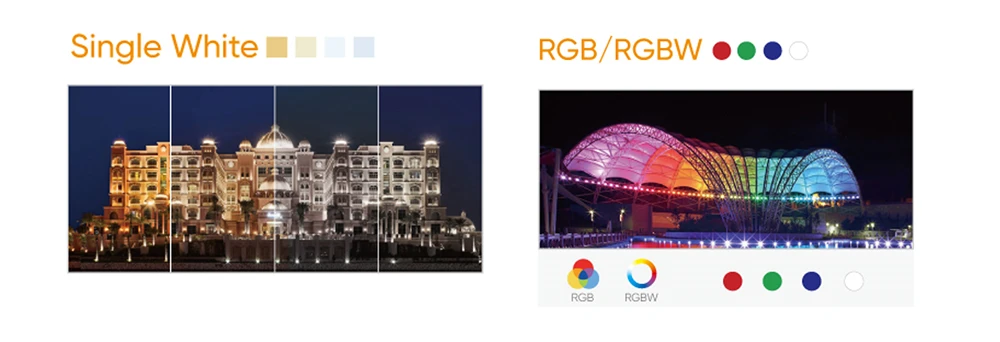
Beam angle
The beam angle affects light distribution. Normally, narrow beam angles (15° - 30°) are ideal for accenting specific features, while wider angles (60° - 120°) work well for general illumination.
AGC Lighting provides a wide range of optics to meet your different needs. Some special beam angles, like 15x30° and 20x60°, are perfect for grazing the facade. These beam angles drop shadows and create a continuous line of light, effectively highlighting the texture of the facade.
Our RGB/RGBW architectural lights, FL59 Vibrancy and FL39 Cellos, feature an ultra-narrow 3° beam angle. This precise, focused beam is capable of illuminating structures at impressive distances, reaching up to 200 meters in height.

Control options
RGBW lighting systems offer incredible versatility, but to fully harness their potential, they require sophisticated control systems. When selecting fixtures, it's crucial to ensure compatibility with industry-standard protocols like DALI and DMX, or integration capabilities with smart building systems. For flexibility and ease of installation, wireless control options such as Bluetooth are becoming increasingly popular.
DALI (Digital Addressable Lighting Interface): DALI is the go-to choice for energy-efficient, medium to large-scale architectural projects where precise control and reliability are paramount.
DMX (Digital Multiplex): DMX shines in environments that demand dynamic and rapid lighting changes. It's the protocol of choice for theaters and concert venues.
We recently implemented a facade lighting solution for a pharmaceutical company using DMX control with 150W FL39 RGB LED flood lights. This setup allowed for rich, saturated colors and virtually unlimited lighting designs, transforming the building's exterior into a canvas of light.

Bluetooth: Bluetooth control systems are ideal for smaller, simpler installations where user-friendliness and flexibility take priority.
We employed a 2.4GHz Bluetooth wireless LED control system to create captivating RGBW lighting effects for a theme park. The result was a more vibrant, colorful, and visually engaging environment that significantly enhanced the visitor experience.
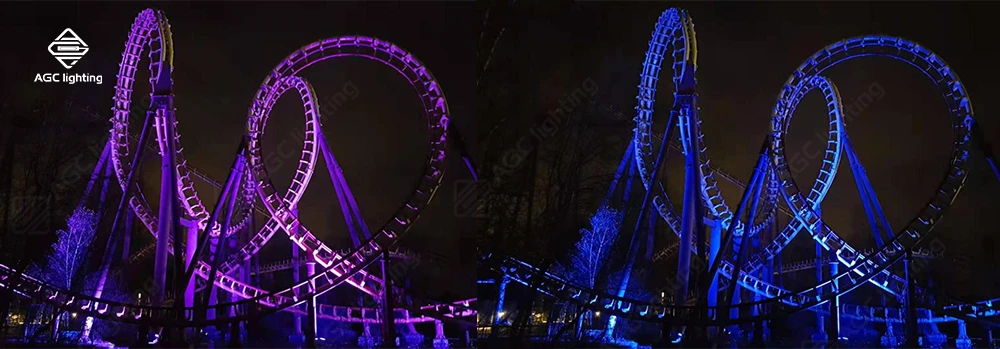
Durability and reliability
Durability and reliability are crucial for any lighting solution, especially in challenging environments. When selecting RGB(W) lights, it’s important to choose fixtures that can withstand environmental factors like humidity, temperature variations, and dust.
Our RGB(W) lights are engineered for exceptional durability and long-term performance, even in outdoor settings. For example, the FL56 Relux features a robust die-cast aluminum housing with a powder-coated finish, offering excellent protection. With an IP66 rating for water and dust resistance, and an IK08 rating for impact resistance, these lights are built to last.

Installation and maintenance
Installation and maintenance labor costs can add up significantly for architectural lighting projects. However, our plug-and-play RGB(W) architectural lights are designed to minimize these expenses by offering faster and more efficient connectivity, allowing you to achieve stunning color displays with reduced installation time.
We also offer a wide range of installation options and accessories to suit various project requirements, ensuring you find the most cost-effective solution for your lighting needs.
Our lighting designs go beyond just ease of installation. For example, the modular assembly of the FL59 Vibrancy allows for quick and easy part replacements. Additionally, the replaceable lens and PCB components make future maintenance more convenient, while its external driver box that simplifies installation and maintenance processes.
